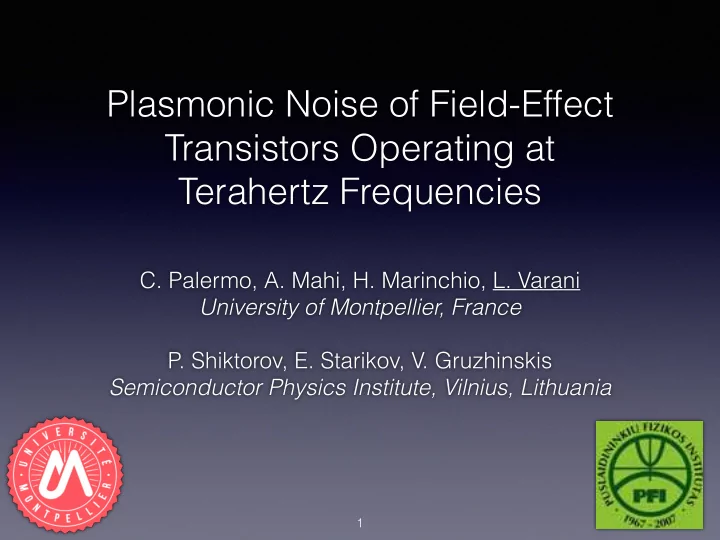

Plasmonic Noise of Field-Effect Transistors Operating at Terahertz Frequencies C. Palermo, A. Mahi, H. Marinchio, L. Varani University of Montpellier, France P. Shiktorov, E. Starikov, V. Gruzhinskis Semiconductor Physics Institute, Vilnius, Lithuania 1
Physical Scenario THz radiation Optical excitation INPUT BOUNDARY MODES dc voltage ac voltage ac carriers generation gate insulator open odd plasma source drain waves Material + geometry closed even STABLE UNSTABLE Non resonant mixed dc complex power response f DETECTION OUTPUT f Homodyne EMISSION Heterodyne Resonant Self oscillations ac/dc response Multiplication f 2
1 st ingredient: Transport ∂ n ∂ t + ∂ nv Continuity ∂ x = 0 v 2 � ∂ v ∂ t + ∂ + e ν D ∂ n 2 + e ∂ x + v ν = ˜ Hydrodynamic m ∗ ϕ f ∂ x Material parameters Effective mass Relaxation rate Diffusion Langevin force ˜ D m ∗ f ν 3
2 nd ingredient: Potential ∂ 2 ϕ Pseudo 2D U g − ϕ d ( x ) δ = e ∂ x 2 + ε s [ n ( x ) − N D ( x )] ε c Poisson ε 0 δ { { longitudinal transverse Geometrical parameters Channel thickness Gate distance 3D 2D d ( x ) δ d δ → ∞ d δ → 0 4
3 rd ingredient: Boundaries ( ϕ (0) = 0 Voltage driven ϕ ( L ) = V D ( ϕ (0) = 0 Current ∂ E ( L,t ) 1 = ε c ε 0 [ j tot − en ( L, t ) v ( L, t )] driven ∂ t External circuit Open circuit Closed Circuit Complex charge Z = R + jX 6 3 2 5 1 4 5
4 th ingredient: Noise Z L n ( x 0 ) | G ξ ( ω , x 0 ) | 2 S ff ( x 0 ) dx 0 S ξξ ( ω ) = 0 Spectral Noise 4 k B T ν ( U Voltage ξ = response source m ∗ J Current function Transfer Impedance Field Voltage and Current Local contribution Admittance,Impedance δ S ξξ S UU , S JJ Y , Z 6
Overview of open problems, critical points, difficulties, etc… 7
PROBLEM 1: NOISE CALCULATION Can we apply Nyquist relation to transistors? 10 drain (10 -21 V 2 m 2 s) S UU ( f ) = 4 k B T < [ Z ( f )] 1 0.1 Impedance S UU field 0.01 0 5 10 15 20 25 f (THz) 8
PROBLEM 2: DIMENSIONALITY What is the role of the channel thickness δ ? δ = 0 1 2 3 4 5 6 δ ≠ 0 1 2 3 4 5 frequency 10 drain (10 -21 V 2 m 2 s) 1 3D 0.1 channel 3D S UU 2D contacts hybrid 0.01 0 5 10 15 20 25 f (THz) 9
PROBLEM 3: ENVIRONMENT Can we tune noise by the embedding circuit? 2.5 2 6 only even 4 2 modes S JJ (10 -8 A 2 s/m 2 ) 1.5 1 odd+even 0.5 modes 0 0 1 2 3 4 5 6 7 8 9 10 5 3 1 f (THz) 2 6 4 10
PROBLEM 4: DEVICE TOPOLOGY What is the effect of gate/channel lengths? gate source drain L n L g L n 3 0.3 drain (10 -21 V 2 m 2 s) Gate ≃ 1 /L g shortening 2 f 1 (THz) 0.2 1 0.1 ≃ 1 /(L g + 2 L n) S UU 0 0 0 100 200 300 400 0 0.5 1 1.5 2 L g (nm) f (THz) 11
PROBLEM 5: NOISE DISTRIBUTION Where the noise comes from? Gate S D 10 12 gate (arb.units) 10 10 10 8 10 6 Local contribution 10 4 δ S JJ 10 2 δ S ξξ = n ( x 0 ) | G ξ ( ω , x 0 ) | 2 S ff ( x 0 ) drain (arb.units) Z L 10 4 S ξξ ( ω ) = δ S ξξ dx 0 10 3 0 10 2 δ S UU 10 1 10 0 0 100 200 300 400 500 600 x 0 (nm) 12
PROBLEM 6: NOISE SUPPRESSION What is the effect of an external excitation? 5 equilibrium 4 S JJ (10 -8 A 2 sm -2 ) 3 Thermally excited 2 1 vs excited 0 optically excited 0 1 2 3 4 5 6 7 8 f (THz) plasmonic noise Optical excitation ac carriers generation gate insulator plasma source drain waves 13
PROBLEM 7: IMPROVE SIGNAL-TO-NOISE How to dephase the collected signals? 100 ϕ = 180 o ϕ = 0 o Average ( μ A) 10 1 0.1 0 2 4 6 8 10 12 14 Frequency (THz) 14
PROBLEM 8: PLASMA INSTABILITY How to reach self-oscillations conditions? V Gate Source Drain I 100 0.45 Increasing drain (10 -21 V 2 m 2 s) Unstable 0.4 current 10 0.35 U ds (V) 1 0.3 0.25 0.1 S UU 0.2 Stable 0.01 0.15 0 0.5 1 1.5 2 2 4 6 8 10 12 14 16 18 20 f (THz) t (ps) 15
Thank you for your attention answers 16
Recommend
More recommend